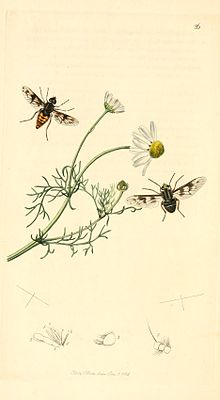Ibis fly
| Ibis fly | ||||||||||||
|---|---|---|---|---|---|---|---|---|---|---|---|---|

Ibis fly ( Atherix ibis ) |
||||||||||||
| Systematics | ||||||||||||
|
||||||||||||
| Scientific name | ||||||||||||
| Atherix ibis | ||||||||||||
| ( Fabricius , 1798) |
The ibis fly ( Atherix ibis ) is a species of fly from the Athericidae family .
features
The flies reach a body length of 9 to 11 millimeters, whereby the broad body is slightly hairy. The thorax is black and has two gray, narrow longitudinal stripes and gray tires on the sides. In the male, the abdomen is marked yellow and black, whereas the female has a black abdomen with gray segment borders. The broad wings protrude far beyond the abdomen and have dark brown colored wing veins and an equally colored Costa cell. The legs of the ibis fly are slender and yellow-brown in color. The short, thick proboscis and the green compound eyes are located on the head .
The larvae of the ibis fly are greenish-brown and reach a length of up to 20 millimeters. They have seven pairs of foot stumps with two hook rings each. At the rear end there is a stump-foot-like pusher and two strong, densely hairy appendages.
habitat
The larvae of the ibis fly occur mainly in clean, moderately to fast flowing waters with a stony or gravelly bottom, which is why they can also be used as a bio-indicator for the water quality ( saprobic index 1.5 - water quality class I-II).
Way of life
The flight time of the species ranges from May to July. Egg-laying begins at the beginning of June, with the females after mating in thousands gather under trees and structures above flowing water. After one female has started laying eggs, the others do the same. After being laid down, the animals die, which quickly creates clumps of thousands of dead ibis flies and their eggs. A few days later the larvae hatch and initially feed on their dead parents. Later, the larvae emerge from inside the lump and drop into the flowing water, where they then feed on carrion and detritus . It is not entirely clear whether the adult ibis fly feeds itself predatory, nectar or even bloodsucking.
literature
Heiko Bellmann : Life in the brook and pond . Mosaik-Verlag, Munich 1998.
Carl Wesenberg-Lund : Biology of freshwater insects, pp. 550–552, Nordisk Forlag, Copenhagen 1943